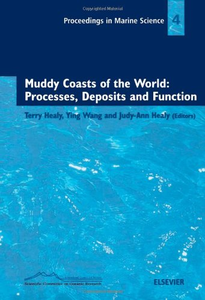Fine sediment dynamics in the mangrove-fringed, muddy coastal zone
Wolanski, Eric, Spagnol, Simon, and Lim, Eng B. (2002) Fine sediment dynamics in the mangrove-fringed, muddy coastal zone. In: Healy, Terry, Wang, Ying, and Healy, Judy-Ann, (eds.) Muddy Coasts of the World: processes, deposits and function. Proceedings in Marine Science, 4 . Elsevier, Amsterdam, The Netherlands, pp. 279-292.
![[img]](https://researchonline.jcu.edu.au/3416/1.hassmallThumbnailVersion/3416_Wolanski_2001_Book_Cover.jpg)
|
Image (JPEG) (Book Cover)
- Cover Image
Download (35kB) |
|
|
PDF (Published Version)
- Published Version
Restricted to Repository staff only |
Abstract
[Extract] Studies of the fate of fine sediment at the mouth of muddy rivers have revealed that the sediment generally falls rapidly out of suspension and does not follow the brackish water in the river plume. The Amazon River plume is a well-documented example (Geyer et a1. 1991; Kineke et al 1996). This observation has been attributed to the formation in coastal waters of large flocs, also called micro-aggregates, that accelerate the settling of the fine sediment. Such flocs have also been found in the Dutch coastal zone (Eisma et a1. 1990), the North Carolina inner shelf (Wells 1989) and the Amazon shelf (Berhane et al. 1997). These floes can exceed many hundreds, sometimes thousands, of µm in diameter. Their settling velocity is thus much higher than that of the floes usual1y found in very turbid estuaries, these flocs are seldom much larger than 100 µm in diameter (Gibbs 1985; Gibbs et at 1989; Wolanski and Gibbs 1995). The formation of micro-aggregates is thus important in controlling the fate of riverine sediment
The processes generating the micro-aggregates have been little studied, though it has been speculated they were biological in nature (Cloern et al. 1983; Nelsen and Trefry 1986; Monaco et al. 1990). Recently Zimmerman and Kausch (1996) and Ayukai and Wolanski (1997) documented the planktonic origin of these micro-aggregates in respectively the Elbe River estuary and the Fly River plume in Torres Strait, Australia. These micro-aggregates essentially formed a mud-affected “marine snow “. The marine snow was previously documented only for the open ocean where there was negligible sediment in suspension (Alldredge and Silver 1988; Alldredge et al. 1993), In the Fly River, plume microphotographs of the undisturbed flocs (Ayukai and Wolanski 1997) revealed that the fine sediment particles that have escaped trapping in the estuary attach themselves to the sticky surface of the marine snow. The resulting micro-aggregates settle out of suspension near the mouth of the Fly River while the plume extends tens of kilometers further offshore. In the case of the Fly River the extremely high turbidity in the estuary prevents significant plankton growth in the estuary itself where the flocs are small (typically <100 µm in diameter; Wolanski and Gibbs 1995). Thus the Fly River estuary behaves like a physical filter while the coastal zone behaves as a biological filter. Presumably in less turbid systems the plankton growth can be significant in the estuary which behaves both as a physical filter and a biological filter; this indeed seems to be the case in the Elbe River estuary (Zimmermann and Kausch 1996). In all these systems the fine sediment settling zone extends onto the inner shelf several kilometers to several tens of kilometers away from the river mouth.
| Item ID: | 3416 |
|---|---|
| Item Type: | Book Chapter (Research - B1) |
| ISBN: | 978-0-444-51019-8 |
| Date Deposited: | 20 Sep 2010 01:21 |
| FoR Codes: | 05 ENVIRONMENTAL SCIENCES > 0501 Ecological Applications > 050102 Ecosystem Function @ 100% |
| SEO Codes: | 96 ENVIRONMENT > 9605 Ecosystem Assessment and Management > 960502 Ecosystem Assessment and Management of Antarctic and Sub-Antarctic Environments @ 100% |
| Downloads: |
Total: 231 Last 12 Months: 3 |
| More Statistics |



